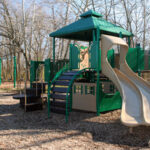Rhetorical Analysis
The use of nature as a rhetorical tool is not a new idea in advertising. It is a staple of advertisements in such areas as cleaning products and cosmetics. In addition, automobiles, and specifically Jeeps have used nature to make a point. Jeep’s advertising aim is to let you know that you can do anything you want in a Jeep including going to the beach, having a picnic, or driving up a mountain. Jeep was originally an army vehicle, so Jeep’s ruggedness has been known of since its inception. Jeep sees this durability as their niche and that is their marketing focus, through the use of several different techniques.
In the chosen advertisement of a 1971 Jeep Commando, there is a couple, parked in their Commando on a beach surrounded by rugged terrain. There are many boulders, and there are waves breaking on the rocks in the background. There are fishing poles in the backseat of the Jeep, and the couple appears to be laughing. The Jeep and terrain appear to be the focus of the advertisement, because the people are hardly visible. One can ascertain that the advertisement is aiming to make us believe that this Jeep can tackle such a difficult landscape with ease and comfort, because the woman is smiling. In addition it can be inferred that after such a rough drive down the rocky beach, the couple can sit down for an afternoon of fishing, displaying the versatility of the vehicle for rugged driving and transportation to a leisure activity.
Layout is another important rhetorical aspect of advertising. In this advertisement, the Jeep is the central figure, while a large heading is present and an inset of text at the bottom. The couple in the vehicle is barely noticeable, so clearly the intention is to show it is a vehicle for anyone, not a specific demographic. Another large portion of the ad is the environment; the large rocks, sand, and body of water. The idea behind this is to emphasize the strength and durability of the vehicle.
There are many different strategies a company can use to advertise a product. One of the obvious strategies in this Jeep advertisement is narration. In the inset text box there is a discussion of the Commando’s strength and power in terms of the engine and the four-wheel drive, while there is an aesthetic discussion of the nine new exterior colors, and a mention of extra leg room. This strategy is more common in older advertisements than newer ones, because in today’s world there is an emphasis on the visual and the concise. There is no time for reading such a block of text in something so unimportant as an automobile advertisement today, where as decades ago, it was perceived to be more worth one’s time to read the fine print.
Another strategy is the coloring of the advertisement. This advertisement is in grayscale, which adds somewhat to the idea of toughness. The absence of color also takes away the reaction to an undesirable color that a viewer of the ad might have, therefore preventing people from dismissing the vehicle based only on visuals. In the case of this advertisement however, the color appears to have only a minute impact.
All of these observations and inferences can be classified under three subheadings; logos, pathos, and ethos. Logos is advertisement that appeals to logic or reason and uses rational argument. Pathos appeals to the emotions and could contain a sad story or a joke. Ethos is an appeal to character or credibility of those in the advertisement itself, such as a spokesperson. A fourth subheading, kairos, the consideration of time and place, is also used in some situations.
In this specific advertisement, the factors are restricted mainly to logos and kairos, with pathos and ethos used only sparingly. Logos is important to this advertisement because there is a lot of explanatory text as well as some subtle messaging. Jeep wants you to make the right choice by telling you that their vehicles have “Never been so strong or so sporty,” and that Jeep is the “Toughest 4-letter word on wheels.” It’s only natural that a consumer would want the top-of-the-line vehicle in strength and sport. The other logical argument that is being made is the argument for versatility. It has a dual function, ruggedness and durability as well as comfort and leisure. The only thing absent from this advertisement that is present in many others is children. Nothing is said about passenger room, or other such points of interest to someone in search of a family car.
Kairos is probably the most important part of this advertisement. Without the setting, the advertisement doesn’t have the same effect. The strength would not be realized without the boulders in the foreground and the waves in the background. The time of day in the advertisement is also important. The ad takes place in the afternoon, but if it had taken place in the morning or evening, the shadows and lighting would have been different. This could possibly alter the perception of the scene or the vehicle. In addition, the time of the ad is important. It is plausible that this advertisement would not have taken place today with the concern over the environment and fossil fuel emissions. Many people do not like the thought of a Jeep on the beach.
Advertising is a melting pot of ideas. Contributions come from logos, pathos, ethos, and kairos, in addition to color, timing, and subject. The use of nature has been a mainstay in advertising since the origin of products. The way nature is used to emphasize certain points of a product can cause different effects within the advertisement and reactions by those viewing it. Jeep knows that nature was and will continue to be a key in their advertising strategy because of the way it exemplifies Jeep’s desirable characteristics.

